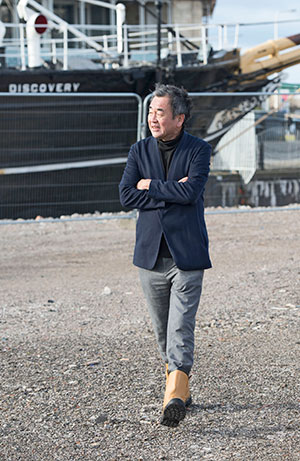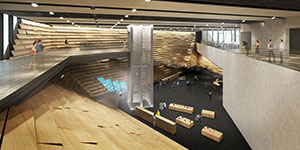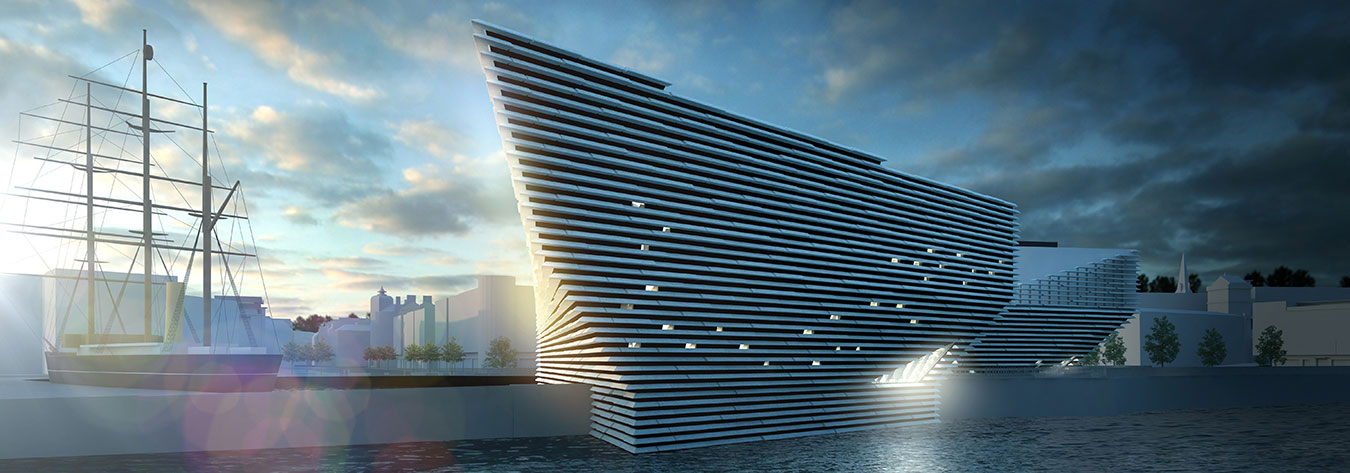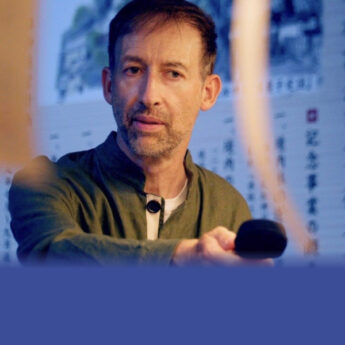Kengo Kuma hits the spot for new UNESCO city of Dundee

Kengo Kuma visited the site in Dundee in March.
A building should be in tune with history and nature, according to world-renowned architect Kengo Kuma, and the first one he has designed in the UK is to be no exception.
Located on the banks of the River Tay, the V&A Museum of Design Dundee will connect the waterfront to the city, with a portion of it floating on the river.
While Kuma said designs for waterfront redevelopments tend to be too commercially orientated and not convey the nature of individual sites, he believes this project will be different.
“For the V&A, I aim for a place that not only invites people to the waterfront, but also shows respect for the nature and people of Scotland”, he told BCCJ ACUMEN.
“I was greatly inspired by the landscape of Dundee, where the water, cliff and earth struggle with each other. That is what I understand as the core of Scotland and I wanted to express it in the architecture”.
Kuma said his connection to Scotland—beginning with a visit nearly 20 years ago—and the similarities between Scottish and Japanese people made it natural for him to apply to design the building.
With the establishment, in 2014, of Dundee as the first and only UNESCO City of Design in the UK, expectations are high for the V&A Dundee.
Delivered by Design Dundee Ltd., the project is a partnership involving the Victoria and Albert Museum in London, Dundee City Council, the University of Dundee, Abertay University and Scottish Enterprise—a public body of the Scottish government.
The £80.11mn building is not only to act as an international centre of design, hosting major exhibitions, but is also expected to give the economy a £11.4mn boost by contributing to the development of the broader hospitality and tourism industries in the region.
It will have access to Scotland-related objects from the V&A’s vast collections as well as objects loaned from collections of national significance across the country and beyond.
The partners hope it will have a great impact on both the city and the country, creating a place that celebrates heritage, inspires contemporary talent and encourages future innovation. Already, the design of the building has been attributed to having started this process.
Speaking at a ground-breaking ceremony at the site on 5 March, Cabinet Secretary for Culture, Europe and External Affairs Fiona Hyslop said, “Kengo Kuma has set out a spectacular vision for V&A Dundee that heralds a bright future for Dundee as the UK’s first UNESCO City of Design”.
Phillip Long, director of the V&A Dundee, said the design of the building symbolises the city’s new confidence.

Wood is the main material to be used in the main hall.
“As the building develops, day-by-day it will demonstrate Dundee’s growing ambition in a very real and physical way”, he added.
In Dundee for the ceremony, Kuma said he was pleased with how the city is developing in terms of design. “It’s always a pleasure to visit Scotland, a country I love very much”, he said.
“When I first arrived for the competition site visit in 2010, Dundee was a very different place. Already you can see the connection between the beautiful waterfront setting, the environment and the city is so much stronger”.
This harmony between buildings and their location is at the heart of Kuma’s work. Giving a keynote address on 21 May at real estate exhibition MIPIM in Tokyo, he said innovative cities are the result of the heritage of the past.
He cited the 1755 Lisbon earthquake and the subsequent fires and tsunami as an example of a trigger that resulted in the adoption of wide roads and open boulevards in Paris.
In the US, too, he attributes the concentration of concrete buildings in Chicago to a change in people’s demands, following the Great Chicago Fire, which destroyed 9km2 and left 100,000 residents homeless. The concept was then transferred to New York, where the first skyscrapers were built and cities began to be made of steel.
While disasters have shaped designs, architects and builders often have assumed they could overcome the powerful force of nature. This is not possible, he said; nature and history are to be respected.
Gravitating to Tokyo due to its relative proximity, the residents of Nakagawa, Tochigi Prefecture, had lost sense of their hometown until Kuma got involved in a local project. His design for the Bato Hiroshige Museum of Art incorporates a large void in the middle of the structure.
This allows visitors and locals to connect with the nearby mountain and shrine: important, but much forgotten, parts of life. The building blends into the natural environment, using traditional, locally sourced materials such as cedar, stone and Japanese washi paper.
Kuma asked the audience to consider what kind of cities Japan wants to make following the Great East Japan Earthquake. Yet, he believes the work of Japanese architects need not be limited to domestic projects.
“Japan is a densely populated country with little habitable land”, he said. “Japanese people therefore have nurtured a sustainable culture under this physically limited environment, which, in many ways, is symbolised by architecture and engineering. I think Japanese architects and engineers can contribute a lot to the rest of the world, particularly in this field”.
The V&A Dundee, one such contribution by Kuma and his firm, is due to open in 2018.
“We look forward to forging even closer links between the people and cultures of Japan and Scotland over the coming years as we create our first British building”, he said.







